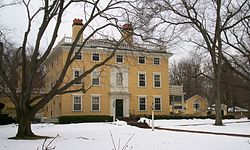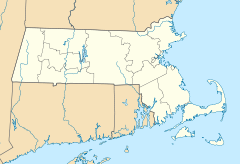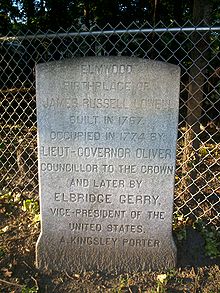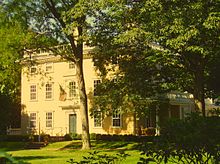- Elmwood (Cambridge, Massachusetts)
-
For other uses, see Elmwood (disambiguation).Elmwood

Location: 33 Elmwood Avenue, Cambridge, Massachusetts Coordinates: 42°22′30.74″N 71°8′19.48″W / 42.3752056°N 71.1387444°WCoordinates: 42°22′30.74″N 71°8′19.48″W / 42.3752056°N 71.1387444°W Built: 1767 Architect: Thomas Oliver Architectural style: Georgian Governing body: Local NRHP Reference#: 66000364 [1] Significant dates Added to NRHP: October 15, 1966 Designated NHLD: December 29, 1962 Elmwood, also known as the Oliver-Gerry-Lowell House,[2] is a registered historic house in Cambridge, Massachusetts, known for its several prominent former residents, including: Andrew Oliver (1706–74), royal Lieutenant Governor of Massachusetts; Elbridge Gerry (1744–1814), signer of the US Declaration of Independence and whose political tactics earned the term gerrymandering, and Vice President of the United States; and James Russell Lowell (1819–1891), noted American writer, poet, and foreign diplomat. It is now the residence of the President of Harvard University.[2]
Contents
History
Early history
The house was built in 1767[2] by Thomas Oliver, Lieutenant-Governor of Massachusetts for a short period until he was forced to resign in September 1774. He fled the colony, initially to Nova Scotia, and then to Bristol, England, where he died in 1815. The house was confiscated at some point during the American Revolution. In 1787 Elbridge Gerry purchased the estate, and in March 1813 took the oath of office as Vice President in the house, where he lived until his death in 1814.
Lowell family
Not long after the death of Elbridge Gerry, Elmwood was purchased by the Lowell family. It was in this home[3] that James Russell Lowell was born on February 22, 1819,[4] the son of Charles Russell Lowell, Sr. and Harriett Brackett Spence Lowell.[5] James Russell Lowell was the youngest of six children; his older siblings were Charles, Rebecca, Mary, William, and Robert.[6]
In the 1850s, Lowell dealt with many personal tragedies, including the sudden death of his mother and his third daughter, Rose.[7] His personal troubles as well as the Compromise of 1850 convinced him to spend a winter in Italy after coaxing from William Wetmore Story.[8] The trip was financed by the sale of land around Elmwood, and Lowell intended to sell off even further. Ultimately, 25 of the original 30 acres (120,000 m2) were sold to supplement Lowell's income.[9] His personal troubles continued: his son Walter died while overseas, his wife Maria White Lowell died in October 1853, his father became deaf, and his sister Rebecca was deteriorating mentally, such that she often went without speaking for weeks. He had difficulty coping and became a recluse at Elmwood for a time[10] until an invitation to speak at the Lowell Institute resulted in a job offer at Harvard College. He accepted the job, with the request he be allowed to study abroad for a year first.
Lowell returned to the United States and began his duties at Harvard in the summer of 1856.[11] Still grieving the loss of his wife, however, he avoided Elmwood. Instead, he lodged in an area known as Professors' Row on Kirkland Street in Cambridge along with his daughter Mabel and her governess Frances Dunlap.[12] Lowell and Dunlap married in 1857. After the death of Lowell's father in January 1861 due to a heart attack, he moved back to Elmwood with his family. Despite avoiding the home for so long, he was pleased to be back. He wrote to his friend Charles Frederick Briggs: "I am back again to the place I love best. I am sitting in my old garret, at my old desk, smoking my old pipe... I begin to feel more like my old self than I have these ten years".[13] However, Elmwood's expenses drained him, with taxes at $1,000 a year. As early as 1867, he considered renting out Elmwood and moving into a smaller home elsewhere but never did. Instead, to ease his financial plight, he began to sell off land in 1870 until only two and a half acres remained his surrounding Elmwood.[14]
Lowell remained at Elmwood for the remainder of his life, except during the period between 1877 and 1885, when he served as Minister to Spain and Great Britain. At Elmwood, he wrote some of his best-known works, including The Vision of Sir Launfal, The Biglow Papers, and A Fable for Critics, all published in 1848.[15] It was Lowell who named the house "Elmwood". He mentions the home in some of his poetry:
- My Elmood chimneys seem crooning to me,
- As of old in their moody, minor key,
- And out of the past the hoarse wind blows.[16]
Lowell's friend and fellow poet Henry Wadsworth Longfellow also wrote a poem about the house called "The Herons of Elmwood".
In the summer of 1872, when Lowell traveled to Europe, he rented the house to Thomas Bailey Aldrich. Years later, in 1877, when Lowell was appointed Ambassador to Spain, he rented the home to the violinist Ole Bull.[17] Shortly after Bull's death in 1880, the Norwegian poet, playwright, and novelist Bjørnstjerne Bjørnson was the guest of Bull's widow at Elmwood for three months.[18] Upon Lowell's return to the United States in 1885, he stayed at Elmwood until his death. He died in the home on August 12, 1891.[15]
Recent history
Elmwood has been owned by Harvard University since 1962 and served as residence for the university's presidents since 1971 when acting Harvard President Derek Bok (1971–1991 & 2006–2007) moved his young family to these bucolic grounds to escape the din of student activity on Quincy Street. Elmwood has continued to serve as the residence of University Presidents since.
Architecture
Although parts of Elmwood's interior have been altered, its exterior has not changed greatly over the years. It is a large, square, clapboarded structure in Georgian style with brick-lined walls and two interior chimneys. All three floors in the main section are bisected into two rooms on either side by a central hall. Its first- and second-story windows are topped by cornices, and a balustrade encloses the low-pitched hip roof. The most striking exterior feature is the entranceway, which is flanked by Tuscan pilasters supporting a classic entablature decorated with a frieze. A large window sits above the entablature and is flanked by Ionic pilasters and topped by a triangular pediment. A one-story porch with balustraded roof deck on the north side of the house, as well as a terrace on the south side, are later additions.
Notes
- ^ "National Register Information System". National Register of Historic Places. National Park Service. 2007-01-23. http://nrhp.focus.nps.gov/natreg/docs/All_Data.html.
- ^ a b c Wilson, Susan. Literary Trail of Greater Boston. Boston: Houghton Mifflin Company, 2000: 112. ISBN 0-618-05013-2
- ^ Heymann, C. David. American Aristocracy: The Lives and Times of James Russell, Amy, and Robert Lowell. New York: Dodd, Mead & Company, 1980: 55. ISBN 0396076084
- ^ Nelson, Randy F. The Almanac of American Letters. Los Altos, California: William Kaufmann, Inc., 1981: 39. ISBN 086576008X
- ^ Sullivan, Wilson. New England Men of Letters. New York: The Macmillan Company, 1972: 205. ISBN 0027886808
- ^ Wagenknecht, Edward. James Russell Lowell: Portrait of a Many-Sided Man. New York: Oxford University Press, 1971: 11.
- ^ Duberman, Martin. James Russell Lowell. Boston: Houghton Mifflin Company, 1966: 116.
- ^ Duberman, Martin. James Russell Lowell. Boston: Houghton Mifflin Company, 1966: 117.
- ^ Wagenknecht, Edward. James Russell Lowell: Portrait of a Many-Sided Man. New York: Oxford University Press, 1971: 36.
- ^ Heymann, C. David. American Aristocracy: The Lives and Times of James Russell, Amy, and Robert Lowell. New York: Dodd, Mead & Company, 1980: 101–102. ISBN 0396076084
- ^ Sullivan, Wilson. New England Men of Letters. New York: The Macmillan Company, 1972: 216. ISBN 0027886808
- ^ Heymann, C. David. American Aristocracy: The Lives and Times of James Russell, Amy, and Robert Lowell. New York: Dodd, Mead & Company, 1980: 106. ISBN 0396076084
- ^ Heymann, C. David. American Aristocracy: The Lives and Times of James Russell, Amy, and Robert Lowell. New York: Dodd, Mead & Company, 1980: 119. ISBN 0396076084
- ^ Duberman, Martin. James Russell Lowell. Boston: Houghton Mifflin Company, 1966: 257–258.
- ^ a b Ehrlich, Eugene and Gorton Carruth. The Oxford Illustrated Literary Guide to the United States. New York: Oxford University Press, 1982: 40. ISBN 0195031865
- ^ Wilson, Susan. Literary Trail of Greater Boston. Boston: Houghton Mifflin Company, 2000: 113. ISBN 0-618-05013-2
- ^ Duberman, Martin. James Russell Lowell. Boston: Houghton Mifflin Company, 1966: 283.
- ^ Haugen, Einar and Eva. Land of the Free: Bjørnstjerne Bjørnson's America Letters, 1880-1881. Northfield, MN: Norwegian-American Historical Association, 1978: 28-30.
External links
- "Fords Occupy Restored Elmwood" by Andrew T. Weil, The Harvard Crimson, September 23, 1963.
- "Elmwood: Molasses, Gerrymandering and Derek" by J. Anthony Day, The Harvard Crimson, March 24, 1971
U.S. National Register of Historic Places Topics Lists by states Alabama • Alaska • Arizona • Arkansas • California • Colorado • Connecticut • Delaware • Florida • Georgia • Hawaii • Idaho • Illinois • Indiana • Iowa • Kansas • Kentucky • Louisiana • Maine • Maryland • Massachusetts • Michigan • Minnesota • Mississippi • Missouri • Montana • Nebraska • Nevada • New Hampshire • New Jersey • New Mexico • New York • North Carolina • North Dakota • Ohio • Oklahoma • Oregon • Pennsylvania • Rhode Island • South Carolina • South Dakota • Tennessee • Texas • Utah • Vermont • Virginia • Washington • West Virginia • Wisconsin • WyomingLists by territories Lists by associated states Other Categories:- Historic districts in Massachusetts
- 1767 architecture
- Houses in Cambridge, Massachusetts
- Landmarks in Cambridge, Massachusetts
- National Historic Landmarks in Massachusetts
- Houses on the National Register of Historic Places in Massachusetts
- My Elmood chimneys seem crooning to me,
Wikimedia Foundation. 2010.



